Class 12 Geography NCERT Solutions Chapter 8 Transport and Communication
Class 12 Geography Chapter 8 NCERT Textbook Questions Solved
1. Choose the right answer from the four alternatives given below:
Question 1.(i)
The Trans-Continental Stuart Highway runs between
(a) Darwin and Melbourne
(b) Edmonton and Anchorage
(c) Vancouver and St. John’s City
(d) Chengdu and Lhasa
Answer:
(a) Darwin and Melbourne
Question 1.(ii)
Which country has the highest density of railway network?
(a) Brazil
(b) U.S.A
(c) Cannada
(d) Russia
Answer:
(b) U.S.A
Question 1.(iii)
The Big Trunk Route runs through
(a) The Mediterranean – Indian ocean
(b) The North Atlantic Ocean
(c) The South Atlantic Ocean
(d) The North Pacific Ocean
Answer:
(b) The North Atlantic Ocean
Question 1.(iv)
The Big Inch pipeline transports
(a) Milk
(b) Liquid petroleum gas (LPG)
(c) Water
(d) Petroleum
Answer:
(d) Petroleum
Question 1.(v)
Which one pair of the following places is linked by Channel Tunnel?
(a) London – Berlin
(b) Paris – London
(c) Berlin-.Paris
(d) Barcelona – Berlin
Answer:
(b) Paris – London
2. Answer the following questions in about 30 words:
Question 2.(i)
What are the problems of road transport in mountainous, desert and flood prone regions?
Answer:
Road transportation depends heavily on the physiography of nature. Mountainous regions: In mountainous regions, irregular terrain makes road construction difficult as cutting through the mountains while construction is not only costly but also dangerous. Also frequent landslides make the roads unfit for use. Desert regions: In desert regions, laying down of roads is not easy as sand does not provide with a strong base for construction of roads. Flood prone regions: In flood prone regions, roads are frequently flooded, hence they cannot be used and remain unfit for use.
Question 2.(ii)
What is a trans-continental railway?
Answer:
Trans continental railways connect two ends of a continent. They are instrumental in economic life of a country. They were constructed for economic and political reasons to facilitate long runs in different directions. They are essential for transportation of not only passengers but mainly of freight. Example; Trans continental Siberian railways.
Question 2.(iii)
What are the advantages of water transport?
Answer:
Water, transport is still the main means of transportation for bulky goods over long distances due to its efficiency. One of the great advantages of water transportation is that it does not require route construction. The oceans are linked with each other and are negotiable with ships of various sizes. All that is needed is to provide port facilities at the two ends. It is much cheaper because the friction of water is far less than that of land.
3. Answer the following questions in not more than 150 words:
Question 3.(i)
Elucidate the statement- “In a well managed transport system, various modes complement each other”.
Answer:
Transport is a service or facility for the carriage of persons and goods from one place to the other using humans, animals and different kinds of vehicles. Such movements take place over land, water and air. The significance of a mode depends on the type of goods and services to be transported, costs of transport and the mode available. International movement of goods is handled by ocean freighters. Road transport is cheaper and faster over short distances and for door- to-door services. Railways are most suited for large volumes of bulky materials over long distances within a country. High-value, light and perishable goods are best moved by airways.
None of the transport system is self-sufficient. For having a well-managed transportation system a proper link between all the modes is essential. Ports are a point of collection of goods carried by waterways; they must have efficient linkage with railways and roadways so that the goods can be taken to interiors. Railways are efficient in connecting far off places but they can’t penetrate deep into interiors or provide door to door service, for that an efficient road system along with transportation facilities like buses etc. should be available.
Question 3.(ii)
Which are the major regions of the world having a dense network of airways?
Answer:
Frequent air services are available to many parts of the world. Although, U.K. pioneered the use of commercial jet transport, U.S.A. developed largely postwar international civil aviation. Today, more than 250 commercial airlines offer regular services to different parts of the world. Recent developments can change the future course of air transport. Supersonic aircraft, cover the distance between London and New York within three and a half hours. In the Northern Hemisphere, there is a distinct east-west belt of inter-continental air routes. Dense network exists in Eastern U.S. A. Westen Fur ope and Southeast Asia. U.S.A. alone accounts for 60 per cent of the airways of the world. New York, London, Paris, Amsterdam, Frankfurt, Rome, Moscow, Karachi, New Delhi, Mumbai, Bangkok, Singapore, Tokyo, San Francisco, Los Angeles and Chicago are the nodal points where air routes converge or radiate to all continents.
Question 3.(iii)
What are the modes by which cyber space will expand the contemporary economic and social space of humans?
Answer:
Human beings have used different methods long-distance communications of which the telegraph and the telephone were important. The telegraph was instrumental in the colonization of the American West. The telephone became a critical factor in the urbanization of America. Even today, the telephone is the most commonly used mode. In developing countries, the use of cell phones, made possible by satellites, is important for rural connectivity. The world soon upgraded their copper cable systems to include optic fiber cables. These allow large quantities of data to be transmitted rapidly, securely, and are virtually error-free. Today internet is the largest electronic network on the planet connecting about 1,000 million people in more than 100 countries.
Artificial satellites, now, are successfully deployed in the earth’s orbit to connect even the remote comers of the globe with limited on-site verification. These have rendered the unit cost and time of communication invariant in terms of distance. Cyberspace is the world of electronic computerized space. It is encompassed by the Internet such as the World Wide Web (www). In simple words, it is the electronic digital world for communicating or accessing information over computer networks without physical movement of the sender and the receiver. It is also referred to as the Internet. Cyberspace exists everywhere. It may be in an office, sailing boat, flying plane and virtually anywhere.
There were less than 50 million Internet users in 1995, about 400 million in 2000 A.D. and over one billion in 2005. The next billion users are to be added by 2010.
As billions use the Internet each year, cyberspace will expand the contemporary economic and social space of humans through e-mail, e-commerce, e-leaning and e-governance. Internet together with fax, television and radio will be accessible to more and more people cutting across place and time. It is these modem communication systems, more than transportation that has made the concept of global village a reality.
Class 12 Geography Chapter 8 NCERT Extra Questions
Class 12 Geography Chapter 8 Very Short Answer Type Questions
Question 1.
Define transport.
Answer:
Transport is a service or facility for carriage of persons or goods from one place to another using animals, humans and different kinds of vehicles, which take place over land, water and air.
Question 2.
What is a transport network?
Answer:
When several places (nodes) are joined together by a series of routes (links), it forms a pattern which is referred to as transport network.
Question 3.
When was the first public railway line opened? Which places did it join?
Answer:
The first public railway line was opened in 1825 between Stockton and Darlington in Northern England.
Question 4.
What are the new modes of land transportation?
Answer:
Pipelines, ropeways and cableways are among the newer developments in land transportation.
Question 5.
What are the two categories of roads?
Answer:
Metalled and unmetalled are two categories of roads.
Question 6.
What are highways?
Answer:
Highways are metalled roads connecting distant places for unobstructed vehicular movement, with separate traffic lanes, bridges, flyovers and dual carriage ways.
Question 7.
Name the terminals for the Trans Canadian highway.
Answer:
Vancouver in British Columbia in West to St. John’s city, in Newfoundland in East.
Question 8.
Name the terminals of Trans-continental Stuart highway.
Answer:
Darwin in the North to Melbourne in the South via Tennant Creek and Alice Springs in Australia.
Question 9.
What are border roads?
Answer:
Border roads are roads laid along international boundaries and play an important role in integrating people of the remote areas with the major cities.
Question 10.
Mention the terminal points of South American trans continental railway.
Answer:
From Buenos Aires, Argentina to Valparaiso, Chile across the Andes Mountains through the Uspallatta Pass.
Question 11.
Define trans-continental railways.
Answer:
Trans-continental railways run across the continent and connects it’s two ends.
Question 12.
Which sea route is called the Big Trunk Route?
Answer:
The North Atlantic sea route is called the Big Trunk Route.
Question 13.
When was the Suez canal constructed?
Answer:
The Suez Canal was constructed in 1869, between Port Said and Port Suez.
Question 14.
Name the seas linked by the Suez canal.
Answer:
Mediterranean and Red Seas are connected by the Suez canal.
Question 15.
Panama canal connects which two oceans?
Answer:
Panama canal connects the Atlantic ocean on the East and Pacific ocean on the west.
Question 16.
How is milk supplied from farms to factories in New Zealand?
Answer:
Milk is supplied from farms to factories in New Zealand through pipelines.
Question 17.
What is Big Inch?
Answer:
Big inch is the pipeline which carries petroleum from the oil wells of Gulf of Mexico to the North Eastern states.
Question 18.
When was Aryabhatt, Rohini and Bhaskar-I launched respectively?
Answer:
Aryabhatta-19, April 1979 Rohini-1980 Bhaskar-I-1979
Question 19.
Why does South Africa has rail connectivity?
Answer:
South Africa has rail connectivity due to the concentration of gold, copper and diamond mining.
Question 20.
Name two countries where commuter trains are popular?
Answer:
Commuter trains are popular in the UK, USA, Japan, India, (any 2)
Question 21.
What is the economic significance of the Trans Canadian Railways?
Answer:
It gained economic significance because it connected the Quebec-Montreal industrial region with the wheat belt of the Prairie region, and the Coniferous forest region in the north, thus making each of them complimentary to the other.
Question 22.
Which sea route has reduced the distance between Europe and Asia?
Answer:
Mediterranean-Indian Ocean sea route through the Suez canal has reduced the distance between Europe and Asia.
Question 23.
Which canal has reduced the distance between New York and San Francisco?
Answer:
Panama canal has reduced the distance between New York and San Francisco.
Question 24.
Which animals are used as carriers?
Answer:
Different animals are used in different places as carriers.
- Horses are used as a draught animal even in the Western countries.
- Dogs and reindeers are used in North America, North Europe and Siberia to draw sledges over snow-covered ground.
- Mules are preferred in the mountainous regions; while camels are used for caravan movement in deserts.
- In India, bullocks are used for pulling carts.
Question 25.
Which continent has the highest highway density? Give statistics to the fact.
Answer:
In North America, highway density is high, about 0.65 km per sq km. Every place is within 20 km distance from a highway. Cities located on the Pacific coast (west) are well-connected with those of the Atlantic Coast (east).
Question 26.
What.is the objective of under construction Pan-American highway?
Answer:
It will connect the countries of South America, North America and Canada.
Class 12 Geography Chapter 8 Short Answer Type Questions
Question 1.
What factors influence the mode of transportation?
Answer:
The significance of a mode depends on the type of goods and services to be transported, costs of transport and the mode available. International movement of goods is handled by ocean freighters. Road transport is cheaper and faster over short distances and for door-to door services. Railways are most suited for large volumes of bulky materials over long distance within a country. High-value, light and perishable goods are best moved by airways. In a well-managed transport system, these various modes complement each other.
Question 2.
Suggest steps for better urban transport solution.
Answer:
For better urban transport system, the following can be adopted:
- Mass rapid transit (MRT)
- Improved public bus service
- Expressways
- Car pool
- Higher parking fees
- Government measures like odd-even car system to regulate traffic flow.
Question 3.
Write a short note on Trans Canadian railways?
Answer:
Trans Canadian railway is 7050km long and runs from Halifax in the east to Vancouver to the West, through Montreal, Ottawa and Winnipeg. It was initially constructed as a part of an agreement to make British Columbia on the West coast join federation of states.
It gained economic significance because it connected the Quebec-Montreal industrial region with the wheat belt of the Prairie region, and the coniferous forest region in the north, thus making each of them complimentary to the other. A loop line connects it to the important waterways of the world. It is the economic artery of Canada, and wheat and meat are important exports on this route.
Question 4.
What are the steps for modernization of waterways?
Answer:
Modem passenger liners (ships) and cargo ships are equipped with radar, wireless and other navigation aids. The development of refrigerated chambers for perishable goods, tankers and specialized ships has also improved cargo transport. The use of containers has made cargo handling at the world’s major ports easier. The sea routes are the cheapest means of transportation for bulky material over long distance as it doesn’t require route construction and maintenance.
Question 5.
What are the factors on which development of inland waterways depend?
Answer:
Rivers, canals, lakes and coastal areas have been important waterways since time immemorial. Boats and steamers are used as means of transport for cargo and passengers. The development of inland waterways is dependent on the navigability width and depth of the channel, continuity in the water flow, and transport technology in use. Rivers are the only means of transport in dense forests. Very heavy cargo like coal, cement, timber and metallic ores can be transported through inland waterways.
Question 6.
What are the problems faced by inland waterways?
Answer:
Though in the ancient times, rivers were the main highways of inland transportation, but they lost importance because of competition from railways, lack of water due to diversion of water for irrigation and their poor maintenance.
Question 7.
How are rivers modified to enhance their navigability?
Answer:
Many rivers have been modified to enhance their navigability by dredging, stabilising river banks and building dams and barrages for regulating the flow of water.
Question 8.
Write a note on Danube waterway.
Answer:
This important inland waterway serves Eastern Europe. The Danube river rises in the Black Forest and flows eastwards through many countries. It is navigable up to Tauma Severin. The chief export items are wheat, maize, timber and machinery.
Question 9.
Write a note on Volga waterway.
Answer:
Russia has a large number of developed waterways, of which the Volga is one of the most important. It provides a navigable waterway of 11,200 km and drains into the Caspian Sea. The Volga- Moscow Canal connects it with the Moscow region and the Volga-Don Canal with the Black Sea.
Question 10.
Write a note on railways in Australia.
Answer:
Australia has about 40,000 km of railways, of which 25 per cent are found in New South Wales alone. The Australian Trans continental railway rail¬line runs west-east across the southern part of the continent from Perth on the west coast, to Sydney on the east coast passing through Kalgoorlie, Broken Hill and Port Augusta. Another major north- south line connects Adelaide and Alice Spring and to be joined further to the Darwin-Birdum line.
Question 11.
Write a note on the union and pacific railway.
Answer:
This rail-line connects New York on the Atlantic Coast to San Francisco on the Pacific Coast passing through Cleveland, Chicago, Omaha, Evans, Ogden and Sacramento. The most valuable exports on this route are ores, grain, paper, chemicals and machinery.
Question 12.
What is the Orient express?
Answer:
This line runs from Paris to Istanbul passing through Strasbourg, Munich, Vienna, Budapest and Belgrade. The journey time from London to Istanbul by this Express is now reduced to 96 hours as against 10 days by the sea-route. The chief exports on this rail-route are cheese, bacon, oats, wine, fruits, and machinery.
Question 13.
Describe some of the important highways of the world.
Answer:
Important highways of the world:
- Trans-Canadian Highway links Vancouver with St. John’s city.
- Alaskan Highway links Edmonton to Anchorage.
- North American highways link cities of east coasts with that of west coasts.
- Trans-Continental Stuart Highway connects Darwin and Melbourne.
- Pan – American Highway links cities of South America, Central America, and the USA-Canada.
- Golden Quadrilateral in India links metropolitan cities.
- Moscow-Vladiostok Highway serves the east region.
- Highways criss-cross China connecting all major cities.
- Highways join Algiers to Conakry in Africa.
Question 14.
How many types of railway tracks are there?
Answer:
The railway gauges vary in different ‘ countries and are roughly classified as broad (more than 1.5m), standard (1.44 m), metre gauge (1 m) and smaller gauges. The standard gauge is used in the U.K.
Question 15.
Explain the importance of trade, transport and communication.
Answer:
- They link the areas of production with areas of consumption.
- They reduce distance between places of natural resources, manufacturing and market.
- They facilitate the movement and exchange of goods and services and people.
- Today’s world economy heavily depends on efficient trade, transport and communication.
- High living standard and quality of life depend on efficient transport, communication and trade.
- It promotes cooperation and unity among scattered peoples.
Question 16.
Name the longest highway of India. Which other highways are under construction?
Answer:
National Highway No. 7 (NH 7), connecting Varanasi with Kanyakumari, is the longest highway in the country. The Golden Quadrilateral (GQ) or Super Expressway is underway to connect the six metropolitan cities — New Delhi, Mumbai, Bangalore, Chennai, Kolkata and Hyderabad.
Question 17.
What are the important railway routes of African continent?
Answer:
The important routes of the continent are:
- The Beneguela Railway through Angola to Katanga-Zambia Copper Belt
- The Tanzania Railway from the Zambian Copper Belt to Dar-es-Salaam on the coast.
- The Railway through Botswana and Zimbabwe linking the landlocked states to the South African network and
- The Blue Train from Cape Town to Pretoria in the Republic of South Africa.
Question 18.
Write a short note on inter-continental airways.
Answer:
In the Northern Hemisphere, there is a distinct east-west belt of inter-continental air routes. Dense network exists in Eastern U.S.A., Western Europe and Southeast Asia. The U.S.A. alone accounts for 60 per cent of the airways of the world. New York, London, Paris, Amsterdam, Frankfurt, Rome, Moscow, Karachi, New Delhi, Mumbai, Bangkok, Singapore, Tokyo, San Francisco, Los Angeles and Chicago are the nodal points where air routes converge or diverge to all continents.
Question 19.
Bring out the significance of highways in Europe.
Answer:
Europe has a large number of vehicles and a well-developed highway network. But highways face a lot of competition from railways and waterways. In Russia, a dense highway network is developed in the industrialized region west of the Urals with Moscow as the hub. The important Moscow-Vladivostok Highway serves the region to the east. Due to the vast geographical area highways in Russia are not as important as railways.
Question 20.
Why is the North Atlantic sea route significant?
Answer:
This links North-eastern U.S.A. and Northwestern Europe, the two industrially developed regions of the world. The foreign trade over this route is greater than that of the rest of the world combined. One fourth of the world’s foreign trade moves on this route. It is, therefore, the busiest in the world and otherwise, called the Big Trunk Route. Both the coasts have highly advanced ports and harbour facilities.
Class 12 Geography Chapter 8 Long Answer Type Questions
Question 1.
What are advantages and disadvantages of road transport?
Answer:
Advantages:
- Most economical for short distance compared to railways.
- Freight transport by road is gaining importance as it offers door to door service.
- Roads are cheaper, easier and simple to construct and maintain than the railways.
- They can be taken through any terrains and negotiate bends unlike railways..
- Since railways cannot be taken to every corner, so roads play an important role in nation’s trade and commerce and for promoting tourism.
Disadvantages:
- Unmetalled roads are not effective and serviceable throughout the year, even the metalled roads become unmotorable during heavy rains and floods.
- Carrying capacity of roadways per vehicle is much lower than the railways.
- The quality of roads in the developing countries is not good as it requires heavy investment for construction and maintenance.
- City roads suffer from chronic traffic congestion. As a result of this most of the cities face the problem of traffic congestion.
Question 2.
Write a note on North American highways.
Answer:
In North America, highway density is high, about 0.65 km per sq km. Eveiy place is within 20 km distance from a highway. Cities located on the Pacific coast (west) are well-connected with those of the Atlantic Coast (east). Likewise, the cities of Canada in the north are linked with those of Mexico in the south. The Trans-Canadian Highway links Vancouver in British Columbia (west coast) to St. John’s City in Newfoundland (east coast) and the Alaskan Highway links Edmonton (Canada) to Anchorage (Alaska). The Pan-American Highway, a large portion of which has been constructed, will connect the countries of South America, Central America and U.S.A.-Canada.
Question 3.
Write a note on highways in Asia.
Answer:
In China, highways criss-cross the country connecting all major cities such as Tsungtso (near Vietnam boundary), Shanghai (central China), Guangzhou (south) and Beijing (north). A new highway links Chengdu with Lhasa in Tibet.
In India, there are many highways linking the major towns and cities. For example, National Highway No. 7 (NH 7), connecting Varanasi with Kanyakumari, is the longest in the country. The Golden Quadrilateral (GQ) or Super Expressway is underway to connect the six metropolitan cities — New Delhi, Mumbai, Bangalore, Chennai, Kolkata and Hyderabad. In Asia, highway network is most developed in India and China.
Question 4.
Write a note on railways in North America.
Answer:
North America has one of the most extensive rail networks accounting for nearly 40 per cent of the world’s total. In contrast to many European countries, the railways are used more for long-distance bulky freight like ores, grains, timber and machinery than for passengers. The most dense rail network is found in the highly industrialized and urbanized region of East Central U.S.A. and adjoining Canada. In Canada, railways are in the public sector and distributed all over the sparsely populated areas. The transcontinental railways carry the bulk of wheat and coal tonnage.
Question 5.
Give five important points on railways in Europe.
Answer:
Europe has one of the most dense rail networks in the world. There are about 4,40,000 km of railways, most of which is double or multiple-tracked. Belgium has the highest density of 1 km of railway for every 6.5 sq kms area. The industrial regions exhibit some of the highest densities in the world. The important rail heads are London, Paris, Brussels, Milan, Berlin and Warsaw.
Passenger transport is more important than freight in many of these countries. Underground railways are important in London and Paris’. Channel Tunnel, operated by Euro Tunnel Group through England, connects London with Paris. Trans-continental railway lines have now lost their importance to quicker and more flexible transport systems of airways and roadways.
In Russia, railways account for about 90 per cent of the country’s total transport with a very dense network west of the Urals. Moscow is the most important rail head with major lines radiating to different parts of the country’s vast geographical area. Underground railways and commuter trains are also important in Moscow. The Trans-Siberian railways and the Orient express are some of the important railways in the Europe.
Question 6.
Give the advantages of water transport.
Answer:
90-95% of the international trade is carried out through water transport. The energy cost of water transportation is lower. The oceans offer a smooth highway traversable in all directions with no maintenance costs. Winds and oceans currents help in movement of the oceanic vessels thus reducing the fuel cost of transportation.
Compared to land and air, ocean transport is a cheaper means of haulage (carrying of load) of bulky material over long distances from one continent to another. Modern passenger liners (ships) and cargo ships are equipped with radar, wireless and other navigation aids. The development of refrigerated chambers for perishable goods, tankers and specialised ships has also improved cargo transport. The use of containers has made cargo handling at the world’s major ports easier.
Water transport is the only means of transportation in dense tropical forest where roads and railways cannot be constructed. It is also the main mode of transportation for people living on islands as it is economic.
One of the great advantages of water transportation is that it does not require route construction. The oceans are linked with each other and are negotiable with ships of various sizes. All that is needed is to provide port facilities at the two ends. It is much cheaper because the friction of water is far less than that of land. The energy cost of water transportation is lower. It is highly suitable for bulky and heavy commodities. It is eco friendly as ocean currents and winds help to a large extent in water transportation.
Question 7.
Write a note on the Mediterranean- Indian ocean sea route.
Answer:
This sea route passes through the heart of the Old World and serves more countries and people than any other route. Port Said, Aden, Mumbai, Colombo and Singapore are some of the important ports on this route. The construction of Suez canal has greatly reduced the distance and time as compared to the earlier route through the Cape of Good Hope. This trade route connects the highly industrialized Western European region with West Africa, South Africa, South-east Asia and the commercial agriculture and livestock economies of Australia and New Zealand. Before the construction of the Suez Canal this was the route connecting Liverpool and Colombo which was 6,400 km longer than the Suez Canal route. The volume of trade and traffic between both East and West Africa is on the increase due to the development of the rich natural resources such as gold, diamond, copper, tin, groundnut, oil palm, coffee and fruits.
Question 8.
Why cape of good hope sea route has less traffic?
Answer:
This sea route is another important one across the Atlantic Ocean which connects West European and West African countries with Brazil, Argentina and Uruguay in South America. The traffic is far less on this route because of the limited development and population in South America and Africa. Only southeastern Brazil and Plata estuary and parts of South Africa have large-scale industries. There is also little traffic on the route between Rio de Janeiro and Cape Town because both South America and Africa have similar products and resources.
Question 9.
Which canal has shortened the distance between Europe and Asia? Give five points on the canal.
Answer:
Suez canal has shortened the distance between Europe and Asia. This canal had been constructed in 1869 in Egypt between Port Said in the north and Port Suez in the south linking the Mediterranean Sea and the Red Sea.
- It gives Europe a new gateway to the Indian Ocean and reduces direct sea- route distance between Liverpool and Colombo compared to the Cape of Good Hope route.
- It is a sea-level canal without locks which is about 160 km and 11 to 15m deep.
- About 100 ships travel daily and each ship takes 10-12 hours to cross this canal.
- The tolls are so heavy that some find it cheaper to go by the longer Cape Route whenever the consequent delay is not important.
- A railway follows the canal to Suez, and from Ismailia there is a branch line to Cairo.
- A navigable fresh-water canal from the Nile also joins the Suez Canal in Ismailia to supply fresh-water to Port Said and Suez.
Question 10.
Which canal has shortened the distance between eastern and western coasts of North America? What is its economic significance?
Answer:.
Panama canal has shortened the distance between eastern and western coasts of North America. This canal connects the Atlantic Ocean in the east to the Pacific Ocean in the west.
Its economic significance are:
- The canal is about 72 km. long and involves a very deep cutting for a length of 12 km.
- It has a six lock system and ships cross the different levels (26 m up and down) through these locks before entering the Gulf of Panama.
- It shortens the distance between New York and San Francisco by 13,000 km by sea.
- Likewise the distance between Western Europe and the West-coast of U.S.A.; and North-eastern and Central U.S.A. and East and South-east Asia is shortened.
- The economic significance of this Canal is relatively less than that of the Suez. However, it is vital to the economies of Latin America.
Question 11.
Which is the most heavily used inland waterways in the world? Why is it important?
Answer:
Rhine waterway is the most heavily used inland waterways in the world. The Rhine flows through Germany and the Netherlands. It is navigable for 700 km from Rotterdam, at its mouth in the Netherlands to Basel in Switzerland. Ocean-going vessels can reach up to Cologne. The Ruhr river joins the Rhine from the east. It flows through a rich coalfield and the whole basin has become prosperous manufacturing area. Dusseldorf is the Rhine port for this region. Huge tonnage moves along the stretch south of the Ruhr. This waterway is the world’s most heavily used. Each year more than 20,000 ocean-going ships and 2,00,000 inland vessels exchange their cargoes. It connects the industrial areas of Switzerland, Germany, France, Belgium and the Netherlands with the North Atlantic Sea Route.
Question 12.
What are advantages and disadvantages of air transport?
Answer:
Advantages:
- It is the fastest means of transportation.
- Comfortable for long distance travel.
- Suitable for rapid movement of valuable and perishable cargo.
- It is the only means to reach inaccessible area.
- It is also highly effective during emergency like when routes get blocked due to landslides, avalanches, flood etc.. Strategically airways are very significant.
Disadvantages:
- Costly, not within reach of poor people.
- It is also expensive to maintain aircraft as well as the airports.
- It’s operation dependent on the weather conditions.
- Construction of airports is limited by certain physical constrains.
Question 13.
What are pipelines? Give the advantages and disadvantages of pipeline transportation.
Answer:
Pipelines are used to transport liquids like water, oil, gas for uninterrupted flow.
Advantages:
- It can be taken through any terrain.
- The initial cost is high but the maintenance cost is low.
- It is eco friendly as it requires no fuel.
- It’s operation is not affected by unwanted human intervention.
Disadvantages:
- Solids cannot be transported.
- Any undetected leakage leads to wastage.
Question 14.
What is cyberspace? Write a note on it.
Answer:
Cyberspace is the world of electronic computerized space. It is encompassed by the Internet such as the World Wide Web (www). In simple words, it is the electronic digital world for communicating or accessing information over computer networks without physical movement of the sender and the receiver. It is also referred to as the Internet. Cyberspace exists everywhere. It may be in an office, sailing boat, flying plane and virtually anywhere. As billions use the Internet each year, cyberspace will expand the contemporary economic and social space of humans through e-mail, e-commerce, e-leaming and e-governance. Internet together with fax, television and radio will be accessible to more and more people cutting across place and time. It is these modem communication systems, more than transportation, that has made the concept of global village a reality.
Question 15.
Which hemisphere is served more by the air transport? Why there is less development of it in the other hemisphere?
Answer:
Northern hemisphere is served more by the air transport. In the Northern Hemisphere, there is a distinct east-west belt of inter-continental air routes. Dense network exists in Eastern U.S.A., westren Europe and Southeast Asia. U.S.A. alone accounts for 60 per cent of the airways of the world. New York, London, Paris, Amsterdam, Frankfurt, Rome, Moscow, Karachi, New Delhi, Mumbai, Bangkok, Singapore, Tokyo, San Francisco, Los Angeles and Chicago are the nodal points where air routes converge or radiate to all continents. Africa, Asiatic part of Russia and South America lack air services. There are limited air services between 10-35 latitudes in the Southern hemisphere, due to sparser population, limited landmass and economic development.
Question 16.
Write a note on railways in Asia.
Answer:
In Asia, rail network is the most dense in the thickly populated areas of Japan, China and India. Other countries have relatively few rail routes. West Asia is the least developed in rail facilities because of vast deserts and sparsely populated regions. One of the most important railways of Asia is trans-Siberian Railways, a major rail route of Russia which runs from St. Petersburg in the west to Vladivostok on the Pacific Coast in the east passing through Moscow, Ufa, Novosibirsk, Irkutsk, Chita and Khabarovsk. It is the most important route in Asia and the longest (9,332 km) double-tracked and electrified trans-continental railway in the world.
It has helped in opening up its Asian region to West European markets. It runs across the Ural Mountains Ob and Yenisei rivers. Chita is an important agro-centre and Irkutsk, a fur centre. There are connecting links to the south, namely, to Odessa (Ukraine), Baku on the Caspian Coast, Tashkent (Uzbekistan), Ulan Bator (Mongolia), and Shenyang (Mukden) and Beijing in China. There is a proposal to build Trans Asiatic railway linking Istanbul with Bangkok via Iran, Pakistan, India, Bangladesh and Myanmar.
Question 17.
What is the latest development in the field of communication?
Answer:
Over the years human beings have used different methods long-distance communications of which the telegraph and the telephone were important. Even today, the telephone is the most commonly used mode. In developing countries, the use of cell phones, made possible by satellites, is important for rural connectivity. Today there is a phenomenal pace of development. The first major breakthrough is the use of optic fiber cables (OFC). Faced with mounting competition, telephone companies all over the world soon upgraded their copper cable systems to include optic fiber cables.
These allow large quantities of data to be transmitted rapidly, securely, and are virtually error- free. With the digitisation of information in the 1990’s, telecommunication slowly merged with computers to form integrated networks termed as Internet. Internet is the largest electronic network on the planet connecting about 1,000 million. As billions use the Internet each year, cyberspace will expand the contemporary economic and social space of humans through e-mail, e-commerce, e-learning and e-governance. Internet together with fax, television and radio will be accessible to more and more people cutting across place and time. It is these modem communication systems, more than transportation, that has made the concept of global village a reality.
Question 18.
Air transport has made world a global village. How? Also explain the significance of air transport.
Answer:
Air transport has brought about a connectivity revolution in the world in many ways. It is the fastest mode of transport. It is because of air transport that there is no place in the world which is more than 35 hours away. Significance of air transport can be understood as follows:
(a) Economic Significance:
- Air transport is used only for high value goods and passengers.
- Valuable goods can be moved rapidly.
- It is preferred for long distance travel.
- It is the easiest way to reach inaccessible areas such as mountainous snowfields or inhospitable deserts. In the Himalayan region, the routes are often obstructed due to landslides, avalanches or heavy snowfall. At such times, air travel is the only alternative to reach a place.
(b) Airways also have great strategic importance:
- Airports with wide facilities have to be built.
- The construction of airports and facilities is very costly. Therefore airports are built in places where the traffic is large.
- It requires large arrangements such as hanger, fuelling, landing facilities.
Class 12 Geography Chapter 8 Map Based Questions
Question 1.
Study the following map carefully and answer the questions given below:
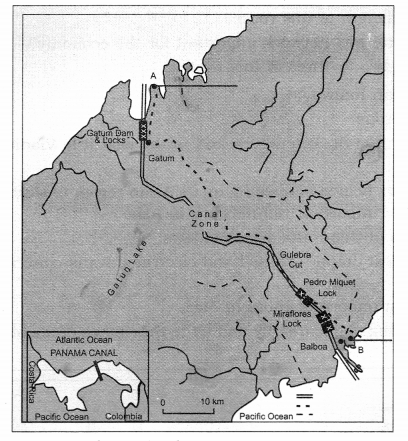
(b) Name the points A and B.
(c) What is the length of this route?
Answer:
(a) Panama Canal
(b) Point A is Colon and point B is Panama.
(c) 72 km
Question 2.
Study the map given below and answer the questions that follow:
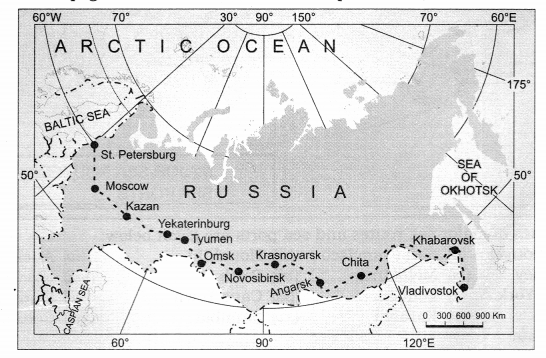
(a) Name the transport route shown in the map.
(b) Name the continents connected with this route.
(c) Name the extreme points of this route.
(d) What is the length of this route?
(e) How is this railway network important for the economy?
(f) Explain any two features of this route.
Answer:
(a) Trans-Siberian Railway
(b) Asia and Europe
(c) In the West, it is St. Petersburg and in the east it is Vladivostok
(d) 9332 km
(e) This route has helped in opening up its Asian region to west European markets. It is the most important rail network in Asia.
(f) Two features of this route are as follows:
- It is the longest double-tracked and electrified trans-continental railway in the world.
- It is the most important route in Asia.
Question 3.
Study the following map carefully and write the names of major sea routes and sea ports.
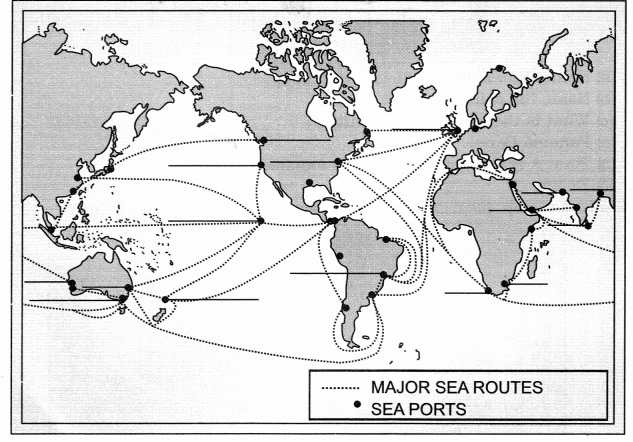
Answer:
The names of major sea routes and sea ports are given below:
(i) Vancouver
(ii) San Francisco
(iii) Honolulu
(iv) Auckland
(v) Sydney
(vi) Melbourne
(vii) Perth
(viii) Rio De Janeiro
(ix) New York
(x) London
(xi) Cape Town
(xii) Durban
(xiii) Aden
(xiv) Karachi
(xv) Mumbai
(xvi) Columbo
(xvii) Kolkata
Question 4.
Study the following map carefully and write the names of major airports.
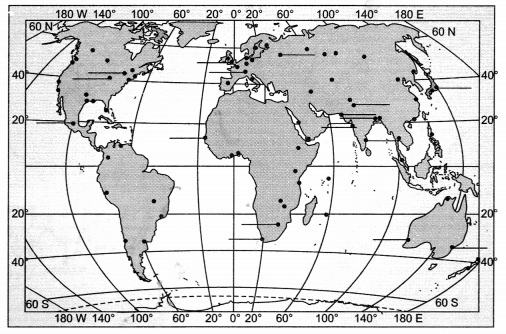
Answer:
The names cf major airports are given below:
(i) New Delhi
(ii) Mumbai
(iii) Chennai
(iv) Kolkata
(v) Karachi
(vi) Tokyo
(vii) Perth
(viii) Sydney
(ix) Moscow
(x) London
(xi) Paris
(xii) Chicago
(xiii) Toronto
(xiv) Mexico
(xv) Cape Town
(xvi) Dhaka
(xvii) Kolkata
Question 5.
Identify the terminal stations of Trans-Continental railways on the political map of the world.
Answer:
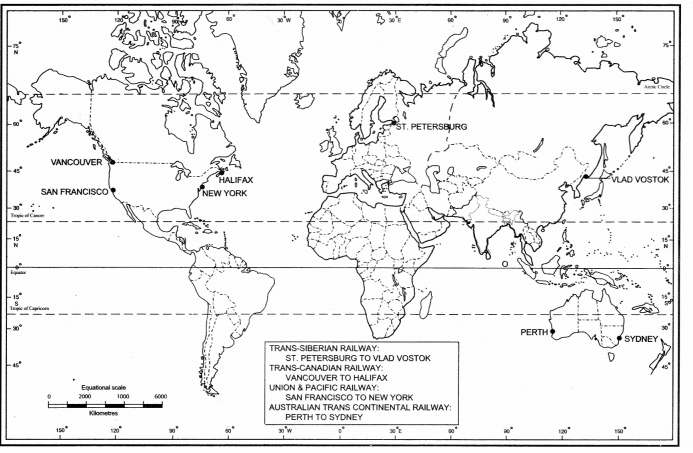
Question 6.
Identify the major sea ports on the political map of the world.
Answer:
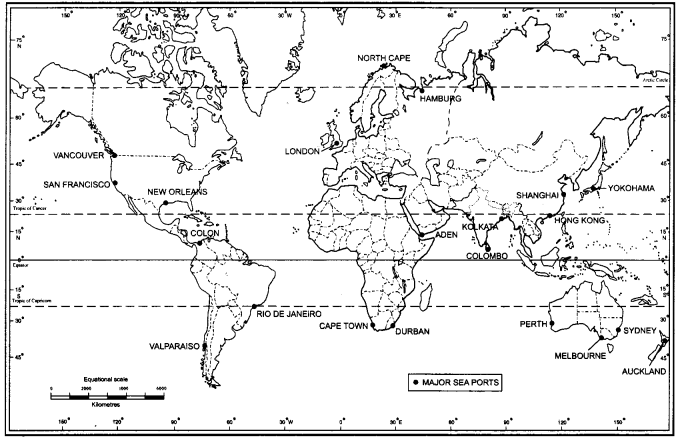
Question 7.
Identify the major airports on the political map of the world.
Answer:
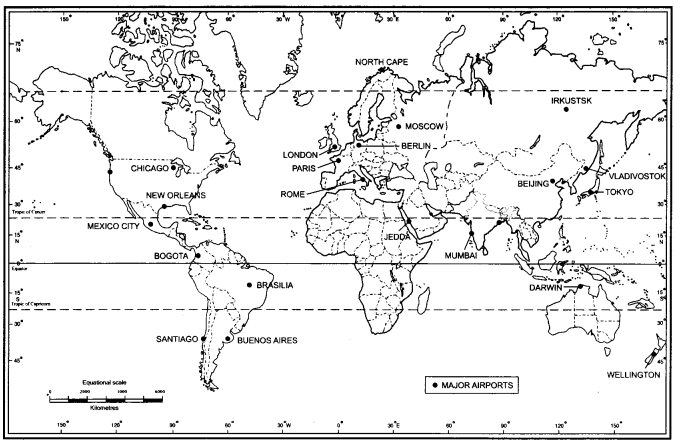
Class 12 Geography Chapter 8 Important Questions
Very Short Answer Type Questions:
Question 1.
Name the inland waterway of Europe that connects Rotterdam and Basel. (Foreign 2006)
Answer:
The Rhine Waterways.
Question 2.
Why are air services limited between 10° and 35° latitudes in the Southern Hemisphere? (Foreign 2006)
Answer:
Due to sparser population, limited landmass and economic backwardness.
Question 3.
Name the terminal stations of the longest railway route in the world. (A.I. 2009)
OR
Name the terminal stations of Trans- siberian Railway. (Delhi 2011, Foreign 2010)
Answer:
St. Petersburg (west) and Vladivostok .(east).
Question 4.
Give the significance of river St. Lawrence as an inland waterway. (CBSE 2011)
Answer:
St. Lawrence waterway serves the most important industrial regions of U.S.A. and Canada.
Question 5.
Which country has the highest road density in the world? (Foreign 2011)
Answer:
Japan has the highest road density in the world.
Question 6.
Name the navigational canal that serves as gateway of commerce for both the continents of Asia and Europe. (Delhi 2011)
Answer:
The Suez Canal.
Question 7.
Name the terminal stations of the Australian Trans-Continental Railway. (Foreign 2010; 2011, Delhi 2009)
Answer:
Perth and Sydney.
Question 8.
Name the terminal stations of the ‘Orient Express’ Railway. (A.I. 2011)
Answer:
Paris and Istanbul.
Question 9.
Which is’the busiest sea route in the world? (A.I. 2011)
Answer:
The North Atlantic Sea Route.
Question 10.
Which highway connects North America and South America? (CBSE 2013)
Answer:
The Pan-American highway connects North America and South America.
Question 11.
Name the seaports on each end of Suez Canal. (CBSE 2014)
Answer:
- Port Said in its north.
- Port Suez in the south.
Question 12.
How is ‘node’ different from “link’ in transport system? (Delhi 2017)
Answer:
Difference between a Node and a Link:
A Node is the meeting point of two or more routes.
A Link is a road that joins two nodes.
Question 13.
“The Volga is one of the most developed inland water-ways in Russia”. Justify. (Delhi 2017)
Answer:
The Volga inland water-way:
- It connects various industrial regions of Russia.
- It connects various navigable canals.
Question 14.
Which country of the world has the highest road density ? (A.I. 2017)
Answer:
Highest Road density in world- Japan (327 for every 100 km2 area)
Question 15.
Why is West Asia the least developed in rail facilities ? Explain one reason. (A.I. 2017)
Answer:
Reasons for Least development in rail facilities in West Asia
- Vast desert area
- Sparsely populated region It is not easy to lay railway lines in desert sands. Further, railways are built to secure large populations. Since West Asia has a sparse population, other modes of transport are more suitable.
Short Answer Type Questions:
Question 1.
Study the following map and answer the questions given below:
(i) Name the shipping canal shown in the map.
(ii) Name the Northernmost and Southern¬most port cities of this canal.
(iii) Which two continents have made more use of this canal?
Answer:
- Suez canal
- North-Port Said, South-Port Suez
- Europe and Asia
Question 2.
Mention any six advantages of Oceanic routes. (Delhi 2009)
OR
Write five advantages of oceanic transport. (CBSE 2004, 05, 13)
Answer:
Six advantages of oceanic routes axe:
- They offer a smooth highway traversable in all directions with no maintenance costs.
- The energy cost of water transportation is lower.
- They are a cheaper means of haulage of bulky material over long distances from one continent to another.
- Very heavy cargo like coal, cement, timber, etc. can be transported through inland waterways.
- They are significant for both domestic and international transport and trade.
- They are the only means of transport in dense forests.
- They are the important highways of commerce.
Question 3.
Mention any six features of ‘Trans- Siberian Railway’. (Delhi 2010)
Answer:
Six features of Trans-Siberian Railways are:
- It runs from St. Petersburg in the west to Vladivostok on the Pacific Coast in the east.
- It passes through Moscow, Ufa, Novosibirsk, Irkutsk, Chita and Khabarovsk.
- It is the most important route in Asia.
- It is the longest (9,332 km) double- tracked and electrified trans-continental railway in the world.
- It has helped in opening up its Asian region to West European markets.
- It runs across the Ural Mountains Ob and Yenisei rivers. Chita is an important agro-centre and Irkuisk, a fur centre.
Question 4.
Study the following map and answer the questions given below: (CBSE 2005, 11)
(i) Name the railway line shown in this map.
(ii) In which country does this railway line lie?
(in) Name the two ocean coasts which are linked by this railway line.
Answer:
- Trans-Australian Railway
- Australia
- Pacific and Indian Oceans are the two ocean coasts linked by this railway line.
Question 5.
Study the following map and answer the questions given below: (CBSE 2005, 09,14)
(i) Name the trans-continental railway shown in the given map.
(ii) Name the terminal stations of this railway line.
(iii) Mentioned any two characteristics of this railway line.
Answer:
(i) Trans Canadian Pacific Railway line.
(ii) Halifax in the east and Vancouver in the west.
(iii) (a) This rail route connects Quebec-Montreal industrial region with the coniferous forest in the north and wheat region of the prairies. Thus both regions are complementary to each other.
(b) A loop line from Winnipeg to Thunder Bay, located on the northern shores of Lake Superior, connects this railway line with the important waterways of North America
Question 6.
What is satellite communication? How has it brought revolutionary changes in the field of communication in the world? Explain? (Foreign 2011)
Answer:
Communication through satellites which emerged as a new area in communication technology is called satellite communication. It has brought revolutionary changes in the field of communication in the world. Artificial satellites are successfully deployed in the earth’s orbit to connect even the remote corners of the globe with limited onsite verification. These have rendered the unit cost and time of communication invariant in terms of distance. This means it costs the same to communicate over 500 km as it does over 5,000 km via satellite.
Question 7.
Explain any three points of economic significance of Trans-Siberian Railway’. (CBSE 2013)
Answer:
Three points of economic significance of Trans-Siberian Railway are:
- It runs through the Chita, which is an important agro-centre and Irkutsk, a fur centre.
- It has helped in opening up its Asian region to West European markets.
- It also connects links to the Ukraine, Uzbekistan, Mongolia and China.
Question 8.
What is Cyberspace? Describe any two advantages of internet. (CBSE 2013)
Answer:
Cyberspace is the electronic digital world for communicating information over computer networks without physical movement of the sender and the receiver. Advantages of internet:
- It exists everywhere.
- It has made the concept of global village a reality.
Question 9.
Study the following map and answer the questions given below: (CBSE 2013, 14)
(i) Name the railway line shown in this map.
(ii) In which country does this railway line lie?
(iii) Name the station marked in the map as A and B.
Answer:
- Trans-Siberian Railway.
- Russia.
- Station A marked in map is Moscow and station B marked in the map is Chita.
Question 10.
Study the map given below carefully and answer the questions that follow: (Delhi 2017)
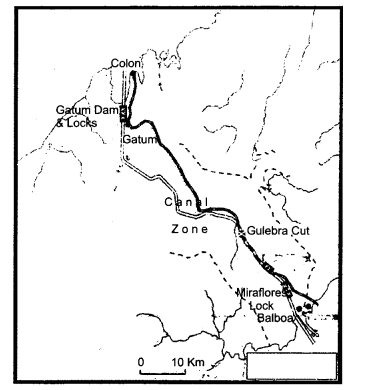
Question 10. (1)
Identify and name the canal shown in the map.
Answer:
Panama Canal
Question 10.(2)
State any four features of this canal.
Answer:
Features of the Panama Canal:
- It connects Atlantic and Pacific Oceans.
- Constructed across Panama Isthmus between Panama City and Colon.
- It involves deep cutting.
- It has six locks system.
- It shortened the distance between the East and the West Coast of USA.
- It has also given a boost to the economy of Latin America.
Question 11.
Study the map given below carefully and answer the questions that follow : (A.I. 2017)
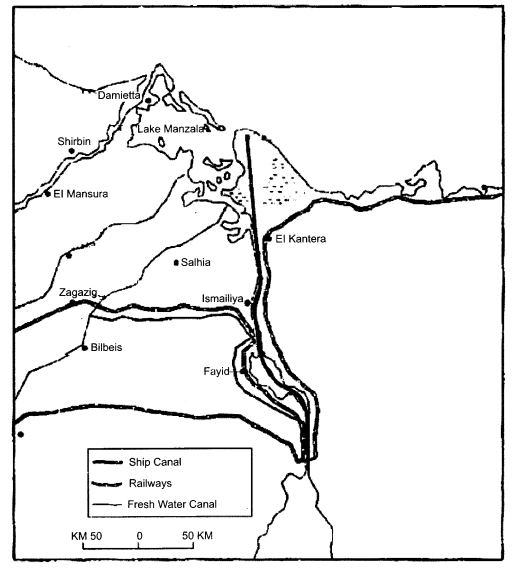
Question 11. (1)
Identify and name the canal shown in the map.
Answer:
Suez canal
Question 11.(2)
Write any four characteristics of this canal.
Answer:
Characteristics
- It connects Mediterranean sea with Red sea.
- It gives Europe a new gateway to the Indian Ocean.
- It reduces distance between Liverpool and Colombo.
- It is Sea level canal without locks.
-
As the tolls are heavy, some find it cheaper to go by the longer Cape Route whenever the consequent delay is not important.
(Any four points to be mentioned)
Question 12.
Describe any three major problems of road transport in the world. (CBSE 2018)
Answer:
Major problems of road transport in the world are:
- Roads are unusable during the time of natural calamity and bad weather conditions.
- Road network cannot cope with the demands of traffic as a result congestion occurs.
- Road construction requires heavy investment in construction and maintenance.
Question 13.
Study the following map of the Suez Canal carefully and answer the questions that follow:
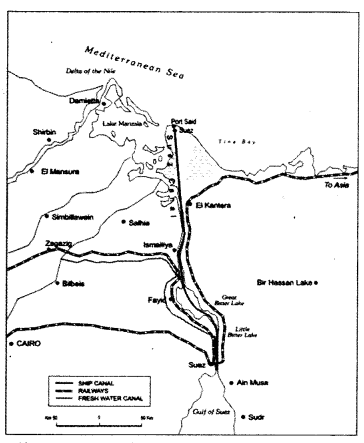
(a) Name the country through which this canal passes.
(b) Name the seas connected by this canal.
(c) Why is this canal considered a gateway of Europe to the Indian Ocean?
Answer:
(a) Egypt
(b) Mediterranean Sea and Red Sea
(c) Gateway of Europe to the Indian Ocean:
- It is considered a gateway of Europe to the Indian Ocean as it reduces the distance between Europe and Asia.
- It gives direct sea route distance between Liverpool and Colombo compared to Cape of Good Hope route.
- It saves time and fuel.
Long Answer Type Questions:
Question 1.
Explain any four points of importance of pipelines in transporting fluid material for long distances with suitable examples from the different parts of the world.
OR
Which is the famous pipeline of the USA? State four advantages of pipeline transport. (CBSE 2004, 05, 06, 08)
OR
Mention the famous oil pipeline of the U.S.A. How are pipelines one of the most convenient mode of transport? Explain any four points. (CBSE 2011)
Answer:
Big Inch is the famous pipeline transport of USA which carries mineral oil from the wells of Gulf of Mexico to the north eastern states.
The advantages of the pipeline transport:
- It is a fast means of transport and it ensures uninterrupted supply of raw material to the refineries and finished products to the consumers.
- It is a cheap means of transport as once constructed it has a very low operational cost.
- It involves use of some energy for pumping only, which is small.
- It saves the problem of loading and unloading of the raw materials and finished products.
Question 2 .
What are the advantages of rail transport? Write four main features of Trans- Siberian Railway. (CBSE 2004, 06, 14)
Answer:
Advantages of rail transport are as follows:
- They are the largest carriers of raw materials to the industries and finished products.
- Due to development of new technology in railway lines, wagons and coaches, engines and operation system, the speed of trains has became more than 300 km per hour.
- It is a cheap means of transport for long distance journey of people and bulky goods.
- It also promotes social and cultural unity by bringing people of different parts of the country together.
Four features of Trans-Siberian Railways are:
- It runs from St. Petersburg in the west to Vladivostok in the east.
- It is a double track route, running for a distance of about 9332km.
- Most of the finished products from Europe Russia are transported to eastern destination.
- Several products like minerals, wood pulp, agricultural and animals’ resources from Siberia are carried to European
- Russia.
Question 6.
What is the importance of roads? Explain any three reasons for the existence of good quality roads in the developed countries.
Answer:
Road transport is the most economical for short distance. Freight transport by road is gaining importance because it offers door-to-door service. It plays a vital role in a nation’s trade and commerce and for promoting tourism.
Three reasons for the existence of good quality roads in the developed countries are:
- They are universal and provide long¬distance links in the form of motorways and autobahns (Germany).
- They also provide inter-state highways for speedy movement.
- Developed countries have good roads and can provide better services.
Question 7.
What are highways? Explain the significance of highways with examples from different continents. (A.I. 2009)
Answer:
Highways are metalled roads connecting distant places that are constructed in such a manner for unobstructed vehicular movement.
The significance of highways from different continents are:
- In North America, highway density is high, about 0.65 km per sq km. The Trans- Canadian Highway links Vancouver in British Columbia (west coast) to St. John’s City in Newfoundland (east coast) and the Alaskan Highway links Edmonton (Canada) to Anchorage (Alaska).
- The Pan-American Highway connects the countries of South America, Central America and U.S.A. – Canada.
- The Trans-Continental Stuart Highway connects Darwin (north coast) and Melbourne via Tennant Creek and Alice Springs in Australia.
- Europe has a large number of vehicles and a well-developed highway network.
- The important Moscow-Vladivostok Highway serves the region to the east. Due to the vast geographical area, highways in Russia are not as important as railways.
- In China, highways criss-cross the country connecting all major cities. A new highway links Chengdu with Lhasa in Tibet.
- In India, there are many highways linking the major towns and cities.
- In Africa, a highway joins Algiers in the north to Conakry in Guinea. Cairo is also connected to Cape Town.
Question 8.
What is the importance of railways as a mode of land transport? Explain any four main features of the railway network in Europe. (A.I. 2015)
Answer:
Railways are a mode of land transport for bulky goods and passengers over long distances. These cariy millions of passengers daily to and fro in the city. There are about 13 lakh km of railways open for traffic in the world.
Features of Railways network in Europe:
- Europe has about 440000 km of railways.
- Most of rail network in Europe is double or multiple tracked.
- The industrial regions have highest densities in the world.
- There is veiy dense network west of the Urals in Russia. Railways account for about 90 per cent of the country’s total transport.
Question 9.
Describe the journey of development of land transport from the days of humans as carriers and the cable ways of todays.
(CBSE 2015)
Answer:
Most of movement of goods and services takes place over land. In early days, humans themselves were carriers. Palki or doli were used as carriers in certain occasions. Later animals were used as beasts of burden. With the invention of wheel, the use of carts and wagons became important. The revolution in transport came about only after the invention of the steam engine. Railways became the most popular and fastest form of land transport. The invention of the internal combustion engine, is revolutionised road transport in terms of road quality and vehicles. Among the newer development in land transportation are pipelines, ropeways and cableways.
Question 10.
Which means of transport is extensively used for carry water, petroleum, natural gas and other liquids? Describe the network of this means of transport in the world. (CBSE 2015)
Answer:
Pipelines are used for carry water, petroleum, natural gas and other liquids. Cooking gas is supplied through pipelines in many parts of the world. In New Zealand, milk is being supplied through pipelines from farm to factories. Big Inch is one of the famous pipelines in USA which carries petroleum from the oil wells of the Gulf of Mexico to the north-eastern states. About 17 per cent of all freight per tonne-km is carried through pipelines in USA. In Europe, Russia, West Asia and India pipelines are used to connect oil wells to refineries and to ports or domestic markets. Turkmenistan in central Asia has extended pipelines to Iran and also to parts of China.
Question 11.
“The Suez and the Panama canals are two vital man-made navigation canals which serve as gateways of commerce for both the eastern and western worlds.” In the light of this statement explain the economic significance of these two canals. (CBSE 2016)
Answer:
Suez Canal:
- It gives Europe a new gateway to the Indian ocean.
- It reduces direct sea route distance between Liverpool and Colombo.
- Before the construction of this canal, Cape of Good Hope route was followed which was very long.
- It is sea level canal, makes journey comfortable.
- Suez canal is very suitable for commerce.
- The economy of Egypt has been changing very fast mainly the income recover from trolls.
Panama Canal:
- It shortens the distance between New York and San Francisco by 13000 km by sea.
- Likewise, the distance between Western Europe and West Coast of U.S.A. is shortened.
- It also shortens the distances between East and North-eastern and Central U.S.A. and East and South East Asia.
- It has a six lock system and ships cross the different levels. It makes journey different levels. It makes journey hardsome even that it save time and money.
- It has provided great boost to the economy of U.S.A and Latin America also.